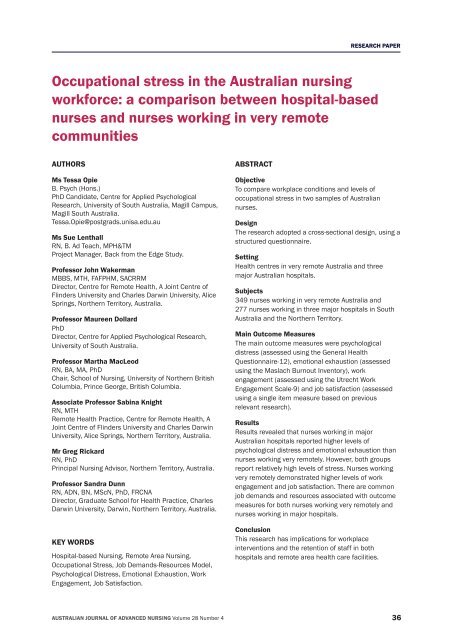Occupational stress in the Australian nursing workforce
Occupational stress in the Australian nursing workforce
Occupational stress in the Australian nursing workforce
Create successful ePaper yourself
Turn your PDF publications into a flip-book with our unique Google optimized e-Paper software.
RESEARCH PAPERDISCUSSIONNurses work<strong>in</strong>g <strong>in</strong> major <strong>Australian</strong> hospitalsreported higher levels of psychological di<strong>stress</strong> andsignificantly higher levels of emotional exhaustionthan nurses work<strong>in</strong>g <strong>in</strong> remote Australia. We propose<strong>the</strong> possibility that <strong>the</strong> prevail<strong>in</strong>g work culturessurround<strong>in</strong>g <strong>the</strong> treatment of occupational <strong>stress</strong><strong>in</strong> each of <strong>the</strong>se nurs<strong>in</strong>g contexts may lend itself tosome justification. For example, a nurse suffer<strong>in</strong>gfrom <strong>stress</strong> <strong>in</strong> a hospital‐based health careadm<strong>in</strong>istration is often presented with <strong>the</strong> optionsof access<strong>in</strong>g counsell<strong>in</strong>g from <strong>the</strong> designatedEmployee Assistance Program (EAP), assum<strong>in</strong>g<strong>stress</strong> leave or apply<strong>in</strong>g for a ward transfer. Whilesome of <strong>the</strong>se options may also be available tonurses work<strong>in</strong>g remotely, staff relief is difficult toachieve <strong>in</strong> remote regions and consequently <strong>the</strong>nurse may rema<strong>in</strong> <strong>in</strong> his/her position, m<strong>in</strong>imis<strong>in</strong>g<strong>the</strong> issue and foster<strong>in</strong>g a more self‐reliant approach.Accord<strong>in</strong>g to Fisher et al (1996, pp. 198) nurseswork<strong>in</strong>g remotely “are reluctant to draw attention to<strong>the</strong>mselves and <strong>the</strong> state of <strong>the</strong>ir job conditions forfear of draw<strong>in</strong>g unwanted media attention to localcommunity problems”. This may help to expla<strong>in</strong> <strong>the</strong>reportedly lower levels of psychological di<strong>stress</strong> andemotional exhaustion for nurses work<strong>in</strong>g <strong>in</strong> veryremote Australia.Results also demonstrated that nurses work<strong>in</strong>gremotely reported higher levels of work engagementand job satisfaction than nurses work<strong>in</strong>g <strong>in</strong> majorhospitals. This f<strong>in</strong>d<strong>in</strong>g is consistent with previousrelevant research. Accord<strong>in</strong>g to Hegney et al(1997), many nurses work<strong>in</strong>g remotely have madea deliberate decision to do so, often because oflifestyle and occupational factors that would beo<strong>the</strong>rwise unavailable to <strong>the</strong>m. Such factors <strong>in</strong>clude<strong>the</strong> remote environment itself and also <strong>the</strong> relativelyautonomous, extended generalist role of remotenurses. Unlike nurses work<strong>in</strong>g <strong>in</strong> a metropolitansett<strong>in</strong>g who perform more consistently <strong>in</strong> acute areasof practice and <strong>the</strong>refore consolidate <strong>the</strong> specialistsroles <strong>the</strong>y carry out, nurses work<strong>in</strong>g remotelyreportedly derive <strong>in</strong>creased job satisfaction from <strong>the</strong>cl<strong>in</strong>ical variety and <strong>the</strong> requirement to use a largerange of advanced skills (Hegney et al 1999).It is <strong>in</strong>terest<strong>in</strong>g to note that some job demandsand job resources were consistent for both nurs<strong>in</strong>gpopulations <strong>in</strong> <strong>the</strong>ir relationships with work outcomes.Workload was significantly positively correlatedto emotional exhaustion, while conflict with o<strong>the</strong>rnurses and supervisors was significantly positivelycorrelated with psychological di<strong>stress</strong> – for bothsamples. Fur<strong>the</strong>rmore, possibilities for developmentand opportunity for professional developmentwere significantly positively correlated with workengagement and job satisfaction, respectively. Aga<strong>in</strong>,this f<strong>in</strong>d<strong>in</strong>g applied to both hospital‐based nursesand nurses work<strong>in</strong>g very remotely.A limitation of <strong>the</strong> study is that <strong>the</strong> analysis iscross‐sectional. Without longitud<strong>in</strong>al analysis weare not able to confirm <strong>the</strong> causal direction of <strong>the</strong>relationships. However, some weight is providedto our <strong>in</strong>terpretation, given that our research is<strong>the</strong>ory‐based and several o<strong>the</strong>r studies support <strong>the</strong>directional hypo<strong>the</strong>sis. Additionally, as we were onlyable to survey those employed at <strong>the</strong> time of surveydistribution, we were unable to access data fromthose nurses who have left <strong>the</strong> profession. Resultsmay consequently under‐represent levels of <strong>stress</strong>and burnout <strong>in</strong> <strong>the</strong> two nurs<strong>in</strong>g populations.CONCLUSIONWhilst levels of occupational <strong>stress</strong> were higher fornurses work<strong>in</strong>g <strong>in</strong> hospital‐based sett<strong>in</strong>gs than nurseswork<strong>in</strong>g <strong>in</strong> very remote regions across Australia,occupational <strong>stress</strong> is clearly a significant workplaceissue for nurses <strong>in</strong> both samples. Levels of <strong>stress</strong> <strong>in</strong>both nurs<strong>in</strong>g populations are undeniably high andpresent important implications for <strong>the</strong> psychologicalwell‐be<strong>in</strong>g of staff <strong>in</strong> both nurs<strong>in</strong>g contexts. Futureresearch should consider workplace <strong>in</strong>terventionsthat address job demands and <strong>in</strong>crease jobresources. While <strong>stress</strong>ors <strong>the</strong>mselves may be unique<strong>in</strong> each nurs<strong>in</strong>g field, demands and resources, and<strong>the</strong>ir impact on work outcomes may be similar for<strong>the</strong>se two nurs<strong>in</strong>g populations.REFERENCESAiken, L. and Patrician, P. 2000. Measur<strong>in</strong>g organizational traitsof hospitals: The revised nurs<strong>in</strong>g work <strong>in</strong>dex. Nurs<strong>in</strong>g Research,49(3):146‐153.AUSTRALIAN JOURNAL OF ADVANCED NURSING Volume 28 Number 4 41
RESEARCH PAPERNakash, R.A., Hutton, J.L., Jørstad‐Ste<strong>in</strong>, E., Gates, S. and Lamb,S.E. 2006. Maximis<strong>in</strong>g response to postal questionnaires‐Asystematic review of randomised trials <strong>in</strong> health research. BMCMedical Research Methodology, 6(1):5.<strong>Occupational</strong> Mortality, 1979‐1983. HSMO, London.Productivity Commission. 2006. Australia’s Health Workforce.Productivity Commission, Editor 2006. <strong>Australian</strong> Government.Sawatzky, A.V. 1996. Stress <strong>in</strong> critical care nurses: Actual andperceived. Heart and Lung: The Journal of Acute and CriticalCare, 25(5):409‐417.Schaufeli, W. and Bakker, A. Utrecht Work Engagement Scaleprelim<strong>in</strong>ary manual. Version 1. Utrecht University, The Ne<strong>the</strong>rlands:<strong>Occupational</strong> Health Psychology Unit, 2003.Schaufeli, W.B., and Bakker, A.B. 2004. Job demands, jobresources, and <strong>the</strong>ir relationship with burnout and engagement:A multi‐sample study. Journal of Organizational Behavior,25(3):293‐315.Siegrist, J. 1996. Adverse health effects of high efforts/lowreward conditions. Journal of <strong>Occupational</strong> Health Psychology,1:27‐41.Yug<strong>in</strong>ovich, J. and H<strong>in</strong>speter, L. 2007. Unf<strong>in</strong>ished Bus<strong>in</strong>ess... <strong>the</strong>impact of s<strong>in</strong>gle nurse cl<strong>in</strong>ics on delivery of primary health care<strong>in</strong> remote communities. Centre for Rural and Remote Area Health,Toowoomba, Qld.Wakerman, J. 2004. Def<strong>in</strong><strong>in</strong>g remote health. <strong>Australian</strong> Journalof Rural Health, 12(5):210‐214.Warr, P. B., Cook, J., and Wall, T. D. 1979. Scales for <strong>the</strong>measurement of some work attitudes and aspects of psychologicalwell‐be<strong>in</strong>g. Journal of <strong>Occupational</strong> Psychology, 52:129‐148.Willis, E. 1991. <strong>Occupational</strong> <strong>stress</strong> and remote area nurses.<strong>Australian</strong> Journal of Advanced Nurs<strong>in</strong>g, 8:18‐26.AUSTRALIAN JOURNAL OF ADVANCED NURSING Volume 28 Number 4 43
















